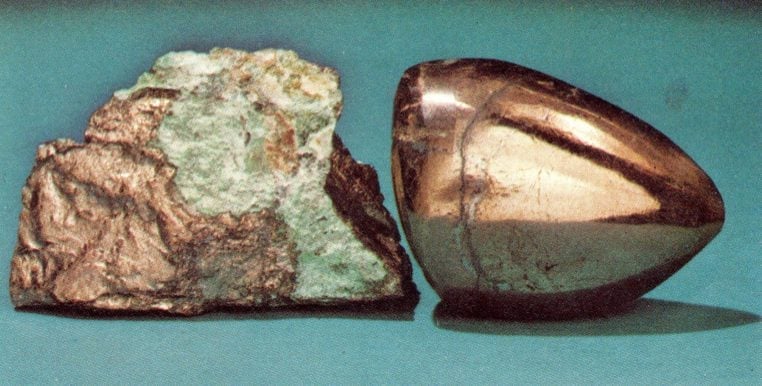Niccolite (Nickeline) Value, Price, and Jewelry Information
Niccolite’s delicate peachy red color and metallic luster looks beautiful when polished. Gem cutters typically carve this gem material into cabochons for jewelry use.
2 Minute Read
Niccolite’s delicate peachy red color and metallic luster looks beautiful when polished. Gem cutters typically carve this gem material into cabochons for jewelry use.
Start an IGS Membership today
for full access to our price guide (updated monthly).Niccolite (Nickeline) Value
Comments
Niccolite (nickel arsenide) belongs to the nickeline group. Of these minerals, only it and (much more rarely) breithauptite occasionally find their way into jewelry as cut pieces.
The term "nickeline" is also used synonymously for the gemstone niccolite itself. In fact, the International Mineralogical Association (IMA) recommends the use of the name "nickeline" over "niccolite." Nevertheless, the latter still enjoys frequent use.
You might also encounter the term "nickelite" used to refer to the gemstone. However, nowadays that name more commonly refers to a tin-based babbitt metal alloy, not the mineral NiAs.
Niccolite's combination of colors and metallic luster make it very distinctive. Although this gem has a lower hardness (5-5.5) than other popular jewelry stones, it has no cleavage. It's tough enough to be worn on pendants, bolo ties, and rings with protective settings.
Identifying Characteristics
Like other metallic gems, niccolites have a colored streak. They leave a pale, brownish black mark. Keep in mind that streak testing can destroy your specimen. Conduct this exam on a piece of rough, never a finished gem, only as a last resort.
Niccolite's unusual pale, peachy, copper-red color and very high specific gravity (7.78) will usually readily distinguish it from most other gemstones. However, these properties as well as its hardness overlap with those of its group mate breithauptite. Breithauptites tend to have a violet tint to their reddish copper color. Their streak is also reddish brown.
Synthetics
Scientists have synthesized niccolite for geological research. However, there is no known jewelry use for this material.
Enhancements
No known gemstone treatments, but a nail polish coating may prevent tarnish. (See the "Care" section below).
Sources
Notable gem-quality sources include:
- Ontario, Canada: Gowganda District; Sudbury District (large masses); Cobalt, Thunder Bay.
- United States: California; Colorado; New Jersey.
- Austria, Czech Republic; France; Germany; Japan; Sonora, Mexico; Morocco; Slovakia.
Stone Sizes
Lapidaries could cut cabochons of any size desired from massive pieces.
Care
Niccolites may tarnish to darker colors, such as gray or black. If exposed to moist air, niccolites may form a green nickel coating known as annabergite. A coat of clear nail polish may prevent this.
Keep any niccolite jewelry or gemstones stored dry to avoid tarnish and separated from harder stones to avoid contact scratches. Niccolites are tough, but avoid rough handling. Wear them as occasional gems. Consult our gemstone jewelry cleaning guide for care recommendations.
Please note that niccolite contains both nickel and arsenic. When cutting this material, avoid ingesting or inhaling particles, protect your eyes, and wash your hands. To learn more about the potential hazards of nickel arsenide and what precautions to take, consult this guide.
Joel E. Arem, Ph.D., FGA
Dr. Joel E. Arem has more than 60 years of experience in the world of gems and minerals. After obtaining his Ph.D. in Mineralogy from Harvard University, he has published numerous books that are still among the most widely used references and guidebooks on crystals, gems and minerals in the world.
Co-founder and President of numerous organizations, Dr. Arem has enjoyed a lifelong career in mineralogy and gemology. He has been a Smithsonian scientist and Curator, a consultant to many well-known companies and institutions, and a prolific author and speaker. Although his main activities have been as a gem cutter and dealer, his focus has always been education. joelarem.com
International Gem Society
Related Articles
Unique Gem Materials for Jewelry Design
Black Diamond Value, Price, and Jewelry Information
Chameleon Diamond Value, Price, and Jewelry Information
Gray Diamond Value, Price, and Jewelry Information
Latest Articles
Celebrity Engagement Rings
Ruby and Sapphire Grading Tools
Cerussite Value, Price, and Jewelry Information
Ouro Verde Quartz: History and Treatment
Never Stop Learning
When you join the IGS community, you get trusted diamond & gemstone information when you need it.
Get Gemology Insights
Get started with the International Gem Society’s free guide to gemstone identification. Join our weekly newsletter & get a free copy of the Gem ID Checklist!
